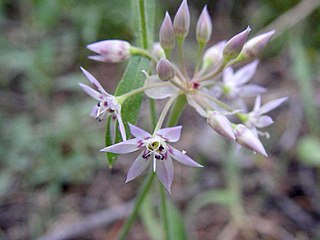
Allium campanulatum is a species of wild onion known by the common name dusky onion or Sierra onion. This is a flowering plant native to the western United States from southeastern Washington and northern Oregon to southern California, and western Nevada. The dusky onion grows in foothills and mountains, especially in dry areas, such as chaparral habitats.
Gayophytum humile is a species of flowering plant in the evening primrose family known by the common name dwarf groundsmoke. It is native to western North America from Alberta to California, and can also be found in parts of South America. It lives in many types of mountain habitats, especially moist areas. It is a small, thin annual herb not exceeding 30 centimeters in height. Its erect stem has few branches and sparse narrow leaves. The stem and leaves are green to bright red, or green with reddish edges and tips. The plant produces tiny white flowers each about half a centimeter across. The fruit is a capsule one to one and a half centimeters long containing up to 50 seeds.

Gentianopsis holopetala is a species of flowering plant in the gentian family known by the common names Sierra fringed gentian or just "Sierra gentian"'. It is native to the Sierra Nevada and adjacent mountains in California and Nevada, in wet meadows from 6000 to 11,000 ft in elevation. This is an annual or perennial herb, growing stems which may be anywhere from a few centimeters long to nearly half a meter, and may lay along the ground or grow erect. Its small oval or spoon-shaped leaves are mostly basal but may grow sparsely further along the stem.
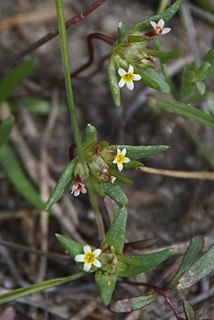
Gymnosteris parvula is a flowering plant in the phlox family known by the common name smallflower gymnosteris. It is native to the western United States from California to Montana. This is a small annual herb growing a thin green to red-colored stem only a few centimeters tall. There are no leaves; the word gymnosteris comes from the Greek for "naked stem". Atop the stem is a large, fleshy inflorescence with red-tinged green bracts that serve as leaves. Within the lobular inflorescence are one to five small flowers, each less than a centimeter long. The yellow-throated flower has yellow or white oval-shaped lobes with pointed tips. It is self-pollinating.
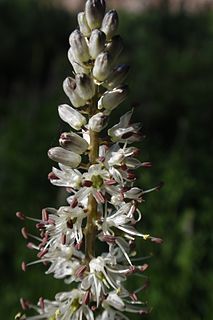
Hastingsia alba is a species of flowering plant known by the common names white rushlily and white schoenolirion.

Hulsea algida is a species of flowering plant in the daisy family, known by the common name Pacific hulsea or alpine gold.

Astragalus layneae is a species of milkvetch known by the common name widow's milkvetch. It is native to the Mojave Desert and surrounding mountain ridges in California and Nevada.
Boechera constancei is a species of flowering plant in the mustard family known by the common name Constance's rockcress. It is endemic to California, where it is known only from the northern Sierra Nevada of Plumas and Sierra Counties. It is a member of the serpentine soils flora. This is a perennial herb growing from a branching, woody caudex. It produces one or more erect, hairless stems to maximum heights between 15 and 30 centimeters. The caudex is surrounded by a dense basal rosette of stiff, blue-green, lance-shaped leaves up to 3 centimeters long. There may be a few smaller leaves along the stem. The inflorescence produces 5 to 10 white mustardlike flowers with protruding stamens. The fruit is a hanging green silique 4 or 5 centimeters long which contains round, winged seeds.
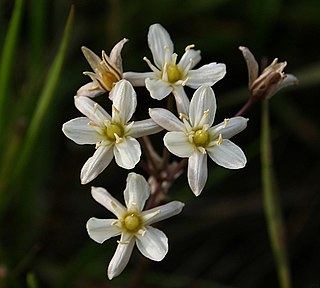
Muilla maritima is a species of flowering plant known by the common names sea muilla and common muilla. It is native to California and Baja California, where it grows in many types of habitats from the coast to the Mojave Desert and Sierra Nevada foothills and other inland mountains, in grassland, woodland, desert, and forest floras. It is a perennial plant growing from a corm and producing an erect flowering stem up to half a meter tall. The onion-like leaves at the base of the stem may be 60 centimeters long. The flowering stem bears an umbel-shaped array of many flowers on pedicels up to 5 centimeters long. Each flower has six tepals which are green-tinged white in color with brownish midribs and no more than 6 millimeters in length. At the center of the flower are six erect stamens with blue, green, or purplish anthers.

Penstemon albomarginatus is an uncommon species of penstemon known by the common name white-margined beardtongue. It is native to the deserts of southern Nevada and western Arizona, as well as in two desert washes in the Mojave Desert in California. It is a perennial herb with several erect stems emerging from a taproot in the sand, their base buried beneath the surface. The stem branches are hairless and somewhat waxy in texture, reaching up to about 35 centimeters tall. The oppositely arranged leaves are oblong or widely lance-shaped, pale green edged in white, and up to 5 centimeters long. The inflorescence produces several purplish-pink tubular flowers between 1 and 2 centimeters long surrounded at the bases by toothed, white-edged sepals. The flower has some hairs in the mouth, but the staminode is hairless. The flowers are pollinated by vespid wasps and probably other insects, such as carabid beetles.
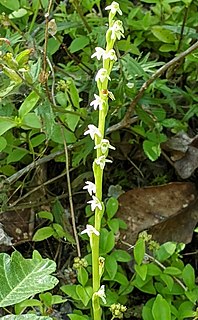
Platanthera ephemerantha is a species of orchid known by the common names whiteflower rein orchid, slender white piperia, and white-flowered piperia. It is native to western North America from Alaska to the San Francisco Bay Area, where it grows in coniferous forests and other habitat in coastal and inland mountain ranges within 150 kilometers of the coast. It grows erect to about half a meter in maximum height from a bulbous caudex. The basal leaves are up to 18 centimeters long by 3 wide. Leaves higher on the stem are much reduced. The upper part of the stem is a spikelike inflorescence of up to 100 small flowers, mostly arranged along one side of the stem. The fragrant, honey-scented flowers are whiter than those of other Platanthera, but sometimes green-tinged or -veined, or green with white margins. The status of this species in the wild is difficult to determine because most populations are small and may produce flowers only rarely.

Pyrrocoma apargioides is a species of flowering plant in the aster family known by the common name alpineflames. It is native to the western United States from the Sierra Nevada of California east to Utah, where it grows in the forests and meadows of high mountains. It is a perennial herb growing from a taproot and producing one or more stems to 30 centimeters in length. The stems are decumbent or upright, reddish, and hairless to slightly woolly. Most of the leaves are located around the base. They are thick and leathery, lance-shaped with large sawteeth along the edges, often center-striped in white, and measure up to 10 centimeters long. The inflorescence is usually a single flower head lined with centimeter-long phyllaries which are reddish to green with red edges. The head has a center of yellow disc florets and a fringe of ray florets which are yellow, often splashed with red along the undersides, measuring up to 1.6 centimeters in length. The fruit is an achene which may be well over a centimeter in length including its pappus.
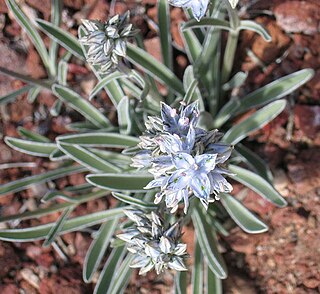
Frasera albicaulis is a species of flowering plant in the gentian family known by the common name whitestem frasera. It is native to the northwestern United States, where it grows in open areas in mountain habitat. It is a perennial herb growing from a woody base surrounded by rosettes of leaves, its stem growing 10 to 70 centimeters tall. The leaves are green with white margins. The basal leaves are lance-shaped, up to 30 centimeters long, and borne on petioles. Leaves higher on the stem are smaller and narrower and are oppositely arranged. The inflorescence is a dense panicle atop the stem, sometimes interrupted into a series of clusters of flowers. Each flower has a calyx of four pointed sepals and a corolla of four pointed lobes each one half to one centimeter long. The corolla is pale greenish white to light blue to purple, often dotted, streaked, or veined with darker blue. There are four stamens tipped with large anthers and a central ovary.
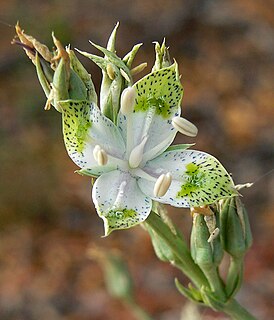
Frasera albomarginata is a species of flowering plant in the gentian family known by the common name desert green gentian, or desert frasera.
Frasera neglecta is a species of flowering plant in the gentian family known by the common name pine green gentian.

Trautvetteria is a genus of flowering plants in the buttercup family. Today it is often considered a monotypic genus, containing only one species, Trautvetteria caroliniensis, which is known by the common names Carolina bugbane, false bugbane, and tassel-rue. A second species, T. japonica, is now generally considered a variety of this species. The genus is named for the botanist Ernst Rudolf von Trautvetter.

Minuartia cumberlandensis is a rare species of flowering plant in the pink family known by the common names Cumberland stitchwort and Cumberland sandwort. It is endemic to the Cumberland Plateau near the Big South Fork of the Cumberland River in Tennessee and Kentucky. This rare plant is found only in cool sandstone rock shelters, on the moist sandy cave floors behind the drip line. There are 27 occurrences in Tennessee and one in Kentucky. The plant is a federally listed endangered species.

Echinocereus viridiflorus is a species of cactus known by the common names nylon hedgehog cactus, green pitaya, and small-flowered hedgehog cactus. It is native to the central and south-central United States and northern Mexico, where it can be found in varied habitat types, including desert scrub, woodlands, dry grasslands, and short-grass prairie.
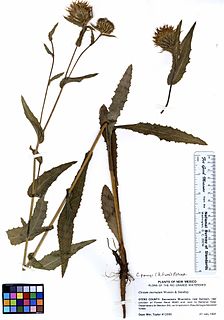
Cirsium parryi, or Parry's thistle, is a species of North American flowering plants in the aster family. It is native to the southwestern United States, where it has been found in Colorado, Arizona, and New Mexico.
Larsenianthus careyanus is a species of the ginger family (Zingiberaceae). It occurs in Bangladesh as well as northeast India. It is the type species of the genus Larsenianthus, which was newly established in 2010.

















